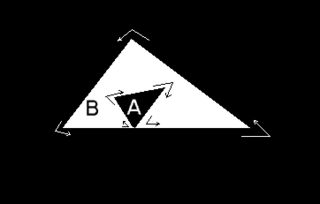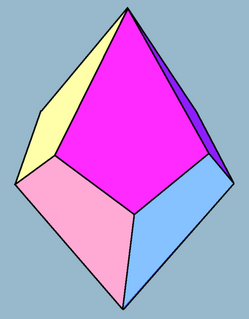In computer science, a Linked list is a linear collection of data elements, whose order is not given by their physical placement in memory. Instead, each element points to the next. It is a data structure consisting of a collection of nodes which together represent a sequence. In its most basic form, each node contains: data, and a reference to the next node in the sequence. This structure allows for efficient insertion or removal of elements from any position in the sequence during iteration. More complex variants add additional links, allowing more efficient insertion or removal of nodes at arbitrary positions. A drawback of linked lists is that access time is linear. Faster access, such as random access, is not feasible. Arrays have better cache locality compared to linked lists.

In geometry, a polyhedron is a solid in three dimensions with flat polygonal faces, straight edges and sharp corners or vertices. The word polyhedron comes from the Classical Greek πολύεδρον, as poly- + -hedron.

Solid modeling is a consistent set of principles for mathematical and computer modeling of three-dimensional solids. Solid modeling is distinguished from related areas of geometric modeling and computer graphics by its emphasis on physical fidelity. Together, the principles of geometric and solid modeling form the foundation of 3D-computer-aided design and in general support the creation, exchange, visualization, animation, interrogation, and annotation of digital models of physical objects.
In algebraic topology, a homology sphere is an n-manifold X having the homology groups of an n-sphere, for some integer n ≥ 1. That is,

Sir Simon Kirwan Donaldson, is an English mathematician known for his work on the topology of smooth (differentiable) four-dimensional manifolds and Donaldson–Thomas theory. He is currently a permanent member of the Simons Center for Geometry and Physics at Stony Brook University and a Professor in Pure Mathematics at Imperial College London.

A polygon mesh is a collection of vertices, edges and faces that defines the shape of a polyhedral object in 3D computer graphics and solid modeling. The faces usually consist of triangles, quadrilaterals, or other simple convex polygons, since this simplifies rendering, but may also be composed of more general concave polygons, or polygons with holes.

In mathematics, a 3-manifold is a space that locally looks like Euclidean 3-dimensional space. A 3-manifold can be thought of as a possible shape of the universe. Just as a sphere looks like a plane to a small enough observer, all 3-manifolds look like our universe does to a small enough observer. This is made more precise in the definition below.
In mathematics, Seifert–Weber space is a closed hyperbolic 3-manifold. It is also known as Seifert–Weber dodecahedral space and hyperbolic dodecahedral space. It is one of the first discovered examples of closed hyperbolic 3-manifolds.
In mathematics, more precisely in topology and differential geometry, a hyperbolic 3–manifold is a manifold of dimension 3 equipped with a hyperbolic metric, that is a Riemannian metric which has all its sectional curvatures equal to -1. It is generally required that this metric be also complete: in this case the manifold can be realised as a quotient of the 3-dimensional hyperbolic space by a discrete group of isometries.

In mathematics, a Kleinian group is a discrete subgroup of PSL(2, C). The group PSL(2, C) of 2 by 2 complex matrices of determinant 1 modulo its center has several natural representations: as conformal transformations of the Riemann sphere, and as orientation-preserving isometries of 3-dimensional hyperbolic space H3, and as orientation preserving conformal maps of the open unit ball B3 in R3 to itself. Therefore, a Kleinian group can be regarded as a discrete subgroup acting on one of these spaces.

In mathematics, topology generalizes the notion of triangulation in a natural way as follows:

The winged edge data structure is a data representation used to describe polygon models in computer graphics. It explicitly describes the geometry and topology of faces, edges, and vertices when three or more surfaces come together and meet at a common edge. Adjacency information is used in algorithms like Subdivision surface. The ordering is such that the surfaces are ordered counter-clockwise with respect to the innate orientation of the intersection edge. Moreover the representation allows numerically unstable situations like that depicted below.

The tetragonal trapezohedron, or deltohedron, is the second in an infinite series of face-uniform polyhedra, which are dual to the antiprisms. It has eight faces, which are congruent kites, and is dual to the square antiprism.
A quad-edge data structure is a computer representation of the topology of a two-dimensional or three-dimensional map, that is, a graph drawn on a (closed) surface.
In mathematics, the Weeks manifold, sometimes called the Fomenko–Matveev–Weeks manifold, is a closed hyperbolic 3-manifold obtained by (5, 2) and (5, 1) Dehn surgeries on the Whitehead link. It has volume approximately equal to 0.94270736… and David Gabai, Robert Meyerhoff, and Peter Milley (2009) showed that it has the smallest volume of any closed orientable hyperbolic 3-manifold. The manifold was independently discovered by Jeffrey Weeks (1985) as well as Sergei V. Matveev and Anatoly T. Fomenko (1988).

MeshLab is a 3D mesh processing software system that is oriented to the management and processing of unstructured large meshes and provides a set of tools for editing, cleaning, healing, inspecting, rendering, and converting these kinds of meshes. MeshLab is free and open-source software, subject to the requirements of the GNU General Public License (GPL), version 2 or later, and is used as both a complete package and a library powering other software. It is well known in the more technical fields of 3D development and data handling.
In mathematics, a 5-manifold is a 5-dimensional topological manifold, possibly with a piecewise linear or smooth structure.

In the mathematical field of knot theory, the hyperbolic volume of a hyperbolic link is the volume of the link's complement with respect to its complete hyperbolic metric. The volume is necessarily a finite real number, and is a topological invariant of the link. As a link invariant, it was first studied by William Thurston in connection with his geometrization conjecture.
The doubly connected edge list (DCEL), also known as half-edge data structure, is a data structure to represent an embedding of a planar graph in the plane, and polytopes in 3D. This data structure provides efficient manipulation of the topological information associated with the objects in question. It is used in many algorithms of computational geometry to handle polygonal subdivisions of the plane, commonly called planar straight-line graphs (PSLG). For example, a Voronoi diagram is commonly represented by a DCEL inside a bounding box.
In mathematics, Seiberg–Witten invariants are invariants of compact smooth 4-manifolds introduced by Edward Witten (1994), using the Seiberg–Witten theory studied by Nathan Seiberg and Witten during their investigations of Seiberg–Witten gauge theory.












